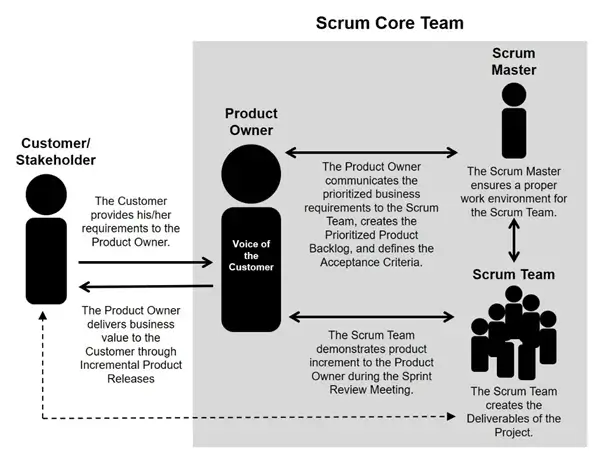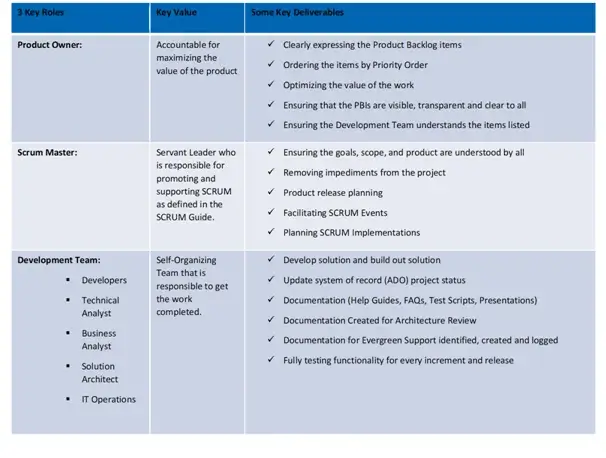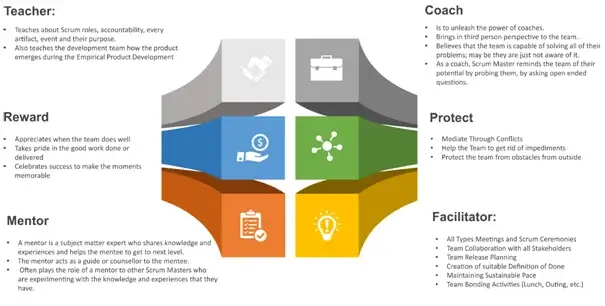Limited Time Offer: Full Feature Access. Plans start @$13 for 11 users Get Started Now
Limited Time Offer: Full Feature Access. Plans start @$13 for 11 users Get Started Now
The Scrum Body of Knowledge Guide (SBOK Guide) has very well defined Scrum roles for successful implementation of Agile Scrum Methodology for product development and project delivery.
In the previous chapter, we provided an overview of how agile methodology came to life and how it gained popularity over the years and was widely accepted across industries.
Continuing our efforts to help you gain more insights into the agile methodology, we would like to help you understand the basics of the Scrum Team and Scrum Roles.
Take a look at the below image to understand how the Scrum Roles are constituted and look in an actual Scrum implementation.


Product Owner (PO) is undoubtedly the "voice of the customer". He owns the product end to end and is responsible for the overall product delivery.
As explained by the Scrum Guide -
"Product owner is a scrum development role for a person who represents the business or user community and is responsible for working with the user group to determine what features will be in the product release."
Having said that it is important to understand the characteristics or expertise of the Product Owner.
He has the most challenging role of wearing multiple hats throughout the product development journey.

A Product Owner plays a crucial role in disseminating the vision and intent of the product, its detailed features, design and the single person to maximize the return on investment of product.
His leadership skills are tested to the core as he is one tasked with conflicting goals, opinions and make decisive final call.
For all practical purposes he is the Backlog Owner. The end to end responsibility of managing, prioritizing and deciding what goes in and out of the backlog lies on the Product Manager.
Some of the key activities in Backlog Management include:
Another important responsibility of the Product Manager is to define the "Acceptance Criteria" and ensure that they are met.
SBOK Guide also maintains that -
"The Product Owner is one person, not a committee. The Product Owner may represent the desires of a committee in the Product Backlog, but those wanting to change a Product Backlog item's priority must address the Product Owner."
As the name indicates, the Scrum Master is one of the most important members of the Scrum Core Team.
A Scrum Master is a "Servant Leader". He is expected to have maximum influence and impact but has minimum to almost no authority.
The primary objective of the Scrum Master is to promote the Scrum Methodology as per the SBOK Guide and help everyone involved understand the Scrum theory, values, practices, roles and events.

But, overall a Scrum Master is a "facilitator". He ensures the development team are provided with a conducive environment to function in a self-organizing manner.
The Scrum Master helps the Development Team and the Product Owner to identify and remove impediments.
Scrum Master also helps the Product Owner understand, adopt and practice scrum to perform his activities successfully.
Overall a Scrum Master is a SME and enables scrum adoption across the organization.
Let us look at the Scrum Master's service to the Product Owner, Development Team and Organization in detail below.
| Product Owner | Development Team | Organization |
|---|---|---|
| Finding techniques for effective Product Backlog management | Coaching the Development Team in self-organization and to work cross functionally | Leading and coaching the organization in its Scrum adoption |
| Helping the Scrum Team understand the need for clear and concise Product Backlog items | Helping the Development Team to create high-value products | Planning Scrum implementations within the organization |
| Understanding product planning in an empirical environment | Removing impediments to the Development Team’s progress | Helping employees and stakeholders understand and practice Scrum and empirical product development |
| Ensuring the Product Owner knows how to arrange the Product Backlog to maximize value | Coaching the Development Teams within the organization | Enabling changes that increases the productivity of the Scrum Team |
| Understanding and practicing agility | Help understand and adopt Scrum Methodology | Enable Scrum adoption to achieve business value |
| Facilitating Scrum events as requested or needed | Facilitating Scrum events as requested or needed | Working with other Scrum Masters to increase the effectiveness of the application of Scrum in the organization |
The Development Team consists of professionals who do the work of delivering a potentially releasable Increment of "Done" product at the end of each Sprint.
Only members of the Development Team create the Increment.
Basic Attributes of the Development Team:
The Development team is accountable for delivering an increment of potentially releasable "Done" product at the end of the Sprint. The Development Team is also accountable for the quality of the "Done" product increment as per the acceptance criteria.
Overview of the Development Team
Agile Methodology maintains distinct roles and responsibilities of the Scrum team thereby enabling absolute collaboration, swift conflict resolution and increases the team’s accountability and ownership.
The guiding principle being "self-organizing" goes a long way in making the team responsible towards their goals. They choose what going to be done with in a sprint and how long will be the sprint.
Overall, a product increment is delivered faster and with quality as the focus is on an increment instead of a huge delivery thereby reducing distractions and improving execution.